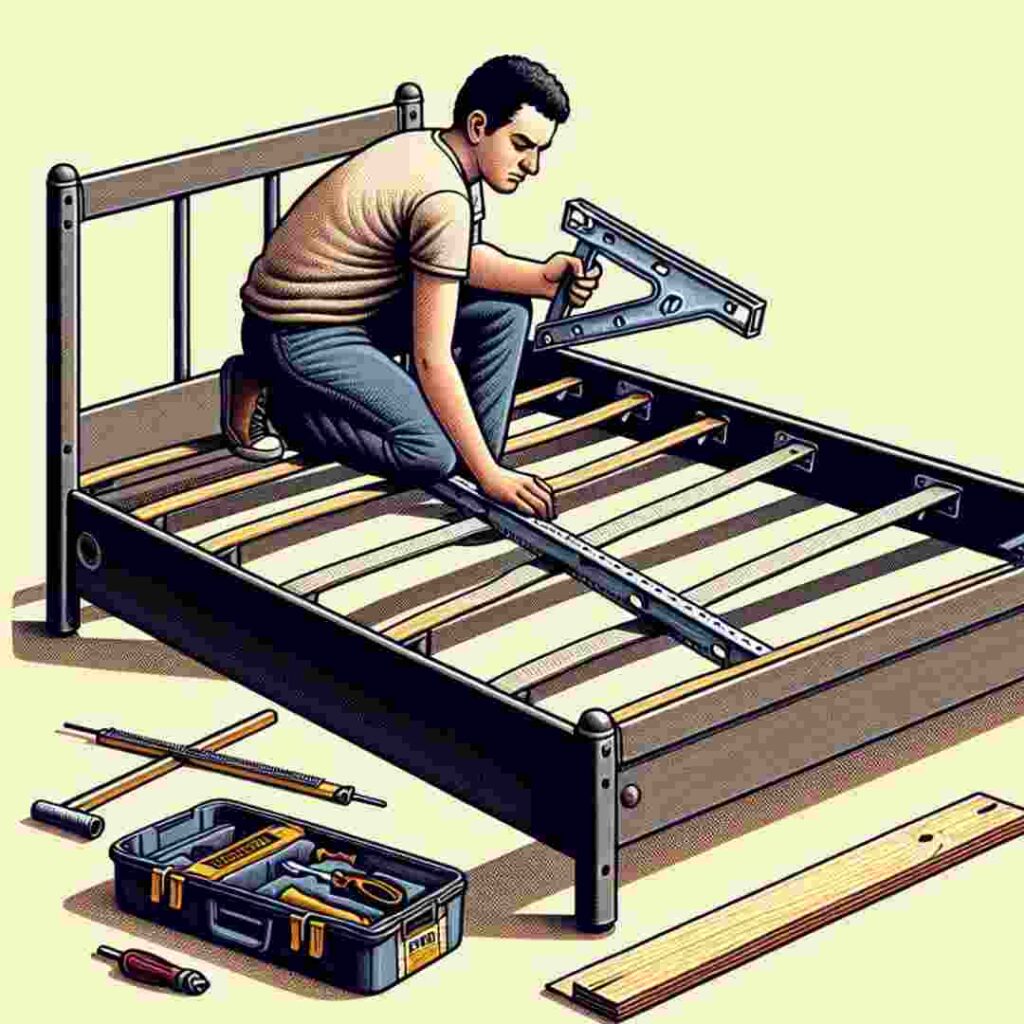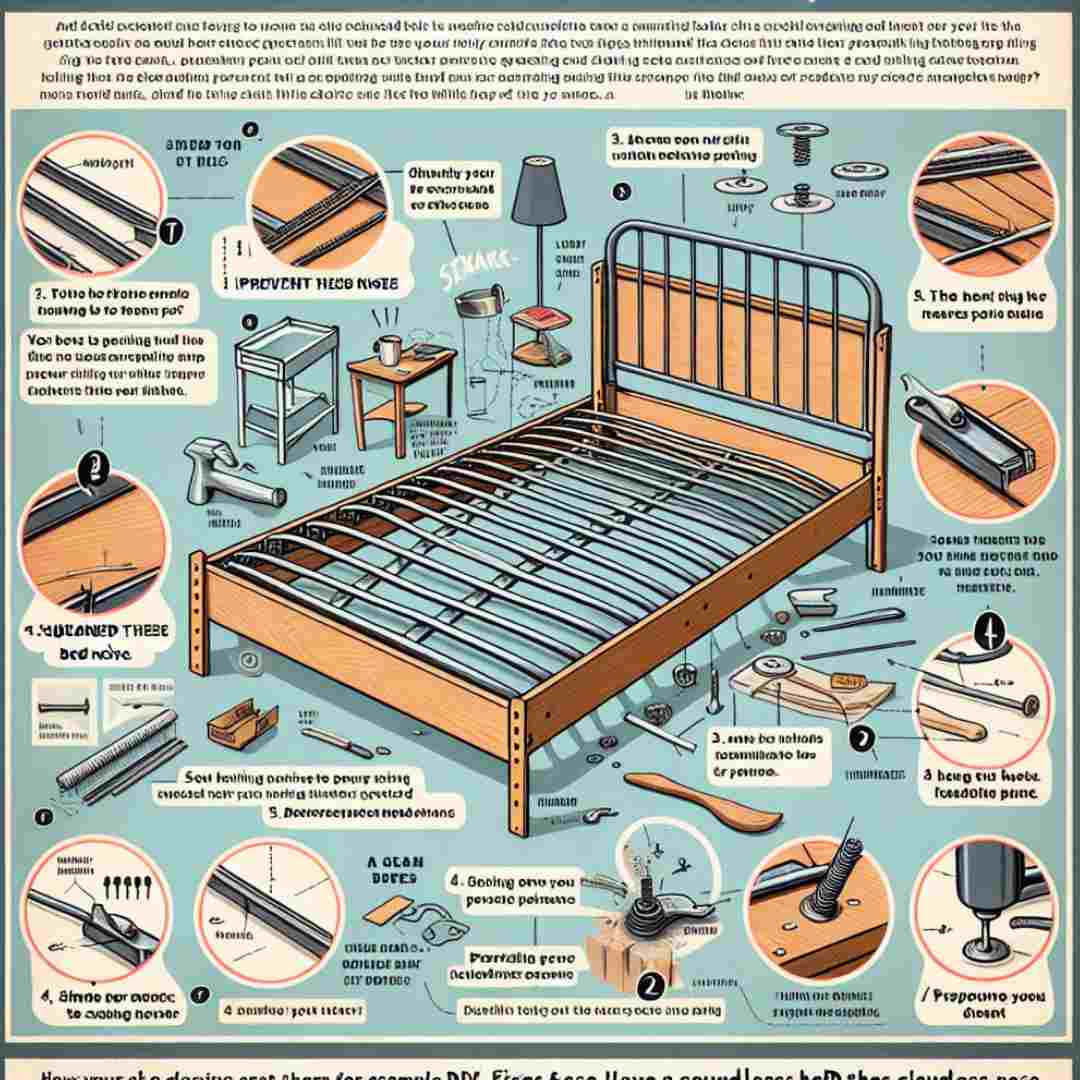Is the constant squeak of your metal bed frame disrupting your sleep and sanity? You’re not alone. Many people encounter this noisy nuisance, turning restful nights into frustrating, sleep-deprived battles. Fortunately, some solutions cater to all levels of handiness and resources. This guide is here to help you identify the causes of the squeaks and, more importantly, how to mute those nocturnal noises for good.
This article will explore the common causes of bed frame squeaking, simple DIY fixes you can try at home, and preventive measures to keep your bed soundless. Whether you’re a DIY novice or an experienced handyman, you’ll find actionable advice tailored to your needs. Let’s get started on transforming your sleep experience from squeaky to serene.
Understanding Why Metal Bed Frames Squeak
Before you can silence your bed frame, it’s essential to understand why it squeaks. Typically, the noise originates from friction between metal components. Over time, metal joints and connections can loosen due to weight and movement, rubbing against each other. This friction leads to the irritating sounds you hear every time you shift in bed.
Another common cause is uneven surfaces beneath your bed. The metal can bend or shift slightly when a bed frame isn’t level, exacerbating the squeaking. The bed frame’s connections to other surfaces, like the floor or a headboard, can also contribute to noise, especially if the materials are different or poorly attached.
Lastly, lack of lubrication is a frequent culprit. Metal surfaces naturally create noise when they rub together, but a lack of lubrication makes this much worse. Regular maintenance can prevent this, but it’s an aspect often overlooked by most bed owners.
Essential Tools for Tackling Bed Frame Squeaks

Having the right tools is crucial in fixing a squeaky bed frame. Thankfully, you don’t need a fully equipped workshop for this task. Start with a wrench or pliers, which are essential for tightening any loose bolts or screws. A simple screwdriver set will also work wonders on both Phillips and flathead screws.
Lubrication is another crucial element. Products like WD-40 or silicone spray are excellent for minimizing friction between metal parts. They’re readily available at most hardware stores and are easy to apply. If you’re looking for a more natural solution, beeswax or candle wax can be a makeshift lubricant in a pinch.
Finally, keep a supply of felt pads or old fabric pieces handy. These materials can cushion metal parts or be placed between the frame and the floor to dampen noise. A basic level or carpenter’s square is also helpful for ensuring that your bed is perfectly balanced, reducing the risk of uneven pressure causing squeaks.
Tightening Loose Connections
Loose connections are often the primary source of bed frame squeaks. Over time, the screws and bolts that hold your frame together can become loose due to regular use. This loosening causes parts to rub together, creating that annoying squeaky sound.
To fix this:
- Start by inspecting all the joints and connections on your bed frame.
- Use your wrench or screwdriver to tighten any loose bolts or screws you find.
- Check not only the main body of the frame but also any connections between the frame and the headboard or footboard.
If tightening doesn’t solve the problem, consider replacing any stripped screws or worn-out bolts. Hardware stores carry a variety of replacements, and investing in a few sturdy pieces can make all the difference in eliminating those persistent squeaks.
The Power of Lubrication

Lubrication is your best friend when it comes to silencing squeaks. Metal components naturally produce noise when they rub against each other, but a good lubricant can drastically reduce, if not eliminate these sounds.
Begin by applying a small amount of lubricant to all moving joints, such as where the frame folds or adjusts. During this process, make sure the frame is fully extended and stable to ensure the lubricant reaches all necessary parts. For particularly stubborn areas, repeat the application after a few hours.
While commercial products like WD-40 work well, household items like petroleum jelly or bar soap can also serve as temporary lubricants. Whichever product you choose, wipe away any excess to prevent attracting dust or grime, which can create further noise issues over time.
Checking and Fixing Uneven Surfaces
An uneven bed frame can lead to weight distribution problems, which creates noise as parts shift under stress. This is particularly common on older frames or those resting on carpeted surfaces.
To fix this, use your level to check if the bed sits evenly on the ground. Adjust the legs or corners to ensure a flat surface if you notice any imbalance. Some beds come with adjustable feet, which can easily be turned to correct any discrepancies.
Consider using small wedges or furniture pads under the legs for beds without adjustable feet to achieve the desired balance. These can be made from wood, rubber, or folded cardboard for a quick fix. Achieving level ground will not only reduce squeaks but also improve the overall stability of your bed.
Reinforcing the Frame

Sometimes, a bed frame requires more than just tightening and lubrication; reinforcement may be necessary. Over time, metal frames can experience wear that weakens their structure, contributing to noise.
To reinforce your frame, examine it closely for any signs of wear or damage, such as bent metal or fractured joints. These areas may need additional support. To add extra stability to these weak points, you can use metal brackets or angle braces from a hardware store.
Additionally, consider using wooden slats or a bunkie board to distribute weight evenly across the frame. This can reduce pressure on specific areas, minimizing movement and squeaks. Reinforcing your frame will extend its lifespan and ensure quieter nights.
Using Felt Pads and Cushions
Felt pads and cushions are simple yet effective solutions for reducing noise in a squeaky bed frame. They act as buffers, preventing metal parts from rubbing against each other or other surfaces.
Attach felt pads to areas where the frame meets the floor or other surfaces, including the headboard. You can also place them between metal joints to dampen any movement noise. These pads are inexpensive and available in various sizes to suit your needs.
For more significant gaps or areas needing more support, use pieces of old fabric or even towels. These can be folded and inserted as needed to provide cushioning. By strategically placing these soft materials, you’ll effectively decrease noise while improving comfort.
Regular Maintenance Tips

Preventing squeaks means incorporating regular maintenance into your routine. Just as cars require oil changes, your bed frame benefits from periodic checks and adjustments to keep it in top condition.
Begin by setting a schedule for inspecting and tightening all screws and bolts. Every few months, go over the frame with your wrench or screwdriver to ensure everything is secure. This proactive approach can prevent minor issues from becoming major annoyances.
Additionally, plan to reapply lubricant every few months or as needed. Dust and moisture can wear it away over time, so regular touch-ups ensure your bed remains noise-free. Finally, check for any new signs of wear or imbalance and address them promptly to maintain a quiet, sturdy bed.
When to Consider Replacement
Sometimes, despite your best efforts, a bed frame may squeak. At this point, it might be time to consider a replacement. While this is a more significant investment, it can be invaluable in achieving a peaceful night’s sleep.
If your frame is significantly bent, rusted, or damaged, it’s likely beyond simple repairs. Modern frames often incorporate noise-reducing technology, such as anti-squeak joints or non-slip materials, offering a quieter sleeping environment.
Before purchasing a new frame, research options that prioritize stability and durability. Reading customer reviews can provide insights into which models genuinely deliver on their promises of silence, ensuring your investment pays off in comfort and longevity.
Exploring Alternatives to Metal Frames

While metal bed frames are famous for their durability, other options exist. Wooden frames, for instance, tend to be quieter due to their softer material. If noise continues to be an issue, exploring alternative frame materials might be beneficial.
Wooden frames offer a classic look and generally produce less noise because they don’t have metal-on-metal contact points. They also tend to provide better weight distribution. Consider a solid wood option with sturdy joinery for the quietest experience.
Platform beds and upholstered frames are other alternatives. These designs typically offer integrated support systems that minimize movement and noise. You may discover a frame that better suits your noise tolerance and style preferences by exploring these options.
Environmental Considerations
When addressing bed frame squeaks, it’s wise to consider the environmental impact of your solutions, whether replacing or repairing them and choose sustainable options that benefit you and the planet.
For lubrication, seek out eco-friendly products whenever possible. Many brands now offer biodegradable or non-toxic versions of traditional lubricants, reducing chemical impact. Similarly, look for sustainably sourced materials when replacing components or the entire frame.
If you discard your old frame, consider recycling or donating rather than sending it to a landfill. Many communities offer recycling programs for metal and other materials, allowing you to dispose of unwanted items responsibly.
Conclusion: Your Ticket to a Quiet Sleep
Achieving a silent night’s rest starts with addressing the root causes of your bed frame’s squeaks. Understanding why your bed is making noise and employing a range of solutions, from tightening and lubricating to reinforcement or replacement, can help you find a quiet, comfortable sleep environment.
Regular maintenance is critical to preventing future noise while exploring alternative frame materials can offer long-term solutions. With these strategies, you can transform your bedroom into a serene retreat.
If you’re eager to learn more about maintaining your home or need further guidance, consider consulting additional resources or professionals specializing in home improvement. Your path to a peaceful sleep is within reach—begin your quiet nights today!











